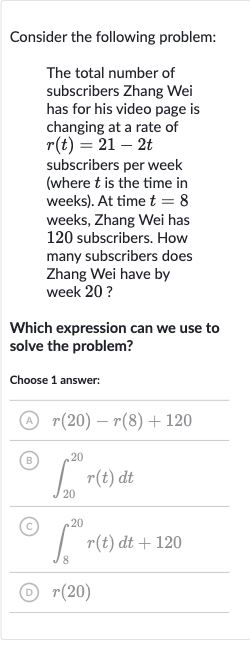AI tutor
Welcome to Bytelearn!
Let’s check out your problem:

Consider the following problem:The total number of subscribers Zhang Wei has for his video page is changing at a rate of subscribers per week (where is the time in weeks). At time weeks, Zhang Wei has subscribers. How many subscribers does Zhang Wei have by week ?Which expression can we use to solve the problem?Choose answer:(A) (B) (C) (D)
Full solution
Q. Consider the following problem:The total number of subscribers Zhang Wei has for his video page is changing at a rate of subscribers per week (where is the time in weeks). At time weeks, Zhang Wei has subscribers. How many subscribers does Zhang Wei have by week ?Which expression can we use to solve the problem?Choose answer:(A) (B) (C) (D)
- Rate of Change Calculation: We are given the rate of change of subscribers as . To find the total change in subscribers from week to week , we need to integrate this rate of change over the interval from to . This will give us the total number of new subscribers added between these two times.
- Integration of Rate of Change: The integral of from to is represented mathematically as . This integral will calculate the total number of subscribers gained or lost over the interval from week to week .
- Performing Integration: To perform the integration, we integrate the function with respect to . The antiderivative of with respect to is , and the antiderivative of with respect to is . So the integral becomes evaluated from to .
- Calculating Upper Limit: Plugging in the upper limit of the integral, we get . Plugging in the lower limit of the integral, we get .
- Calculating Lower Limit: Now we subtract the value of the integral at the lower limit from the value at the upper limit to find the total change in subscribers from week to week . This gives us . However, this is a mistake because when we subtract the lower limit from the upper limit, we should actually get the upper limit value minus the lower limit value, which should be .
More problems from Write two-variable inequalities: word problems
QuestionGet tutor help
QuestionGet tutor help
QuestionGet tutor help
QuestionGet tutor help
QuestionGet tutor help
QuestionGet tutor help
QuestionGet tutor help
QuestionGet tutor help
QuestionGet tutor help
